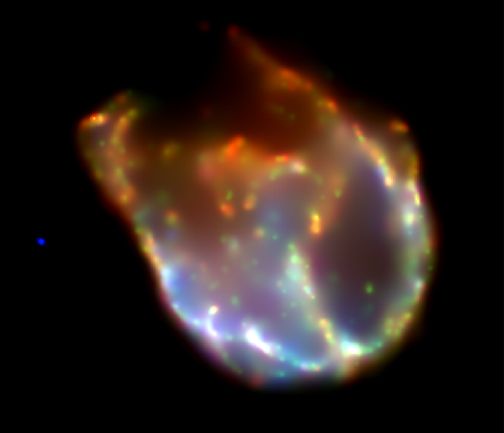
|
Explanation: Supernova remnant N132D shows off complex structures in this sharp, color x-ray image. Still, overall this cosmic debris from a massive star's explosive death has a strikingly simple horseshoe shape. While N132D lies 180,000 light-years distant in the Large Magellanic Cloud, the expanding remnant appears here about 80 light-years across. Light from the supernova blast which created it would have reached planet Earth about 3,000 years ago. Observed by the orbiting Chandra Observatory, N132D still glows in x-rays, its shocked gas heated to millions of degrees Celsius. Since x-rays are invisible, the Chandra x-ray image data are represented in this picture by assigning visible colors to x-rays with different energies. Low energy x-rays are shown as red, medium energy as green, and high energy as blue colors. These color choices make a pleasing picture and they also show the x-rays in the same energy order as visible light photons, which range from low to high energies as red, green, and blue.
|
January February March April May June July August September October November December |
| ||||||||||||||||||||||||||||||||||||||||||||||||
NASA Web Site Statements, Warnings, and Disclaimers
NASA Official: Jay Norris. Specific rights apply.
A service of: LHEA at NASA / GSFC
& Michigan Tech. U.
Based on Astronomy Picture
Of the Day
Publications with keywords: supernova remnant
Publications with words: supernova remnant
See also:
- APOD: 2025 October 1 B NGC 6960: The Witchs Broom Nebula
- APOD: 2025 June 9 B Between Scylla and Charybdis: A Double Cosmic Discovery
- Supernova Remnant Cassiopeia A
- APOD: 2025 January 8 B Supernova Remnants Big and Small
- APOD: 2024 September 18 B The Mermaid Nebula Supernova Remnant
- APOD: 2024 April 16 B Filaments of the Vela Supernova Remnant
- APOD: 2024 April 3 B Unusual Nebula Pa 30
